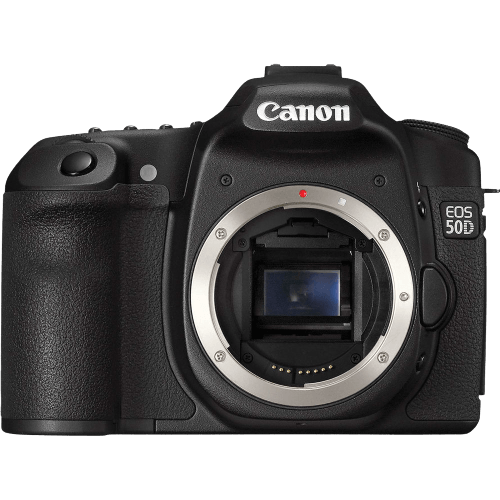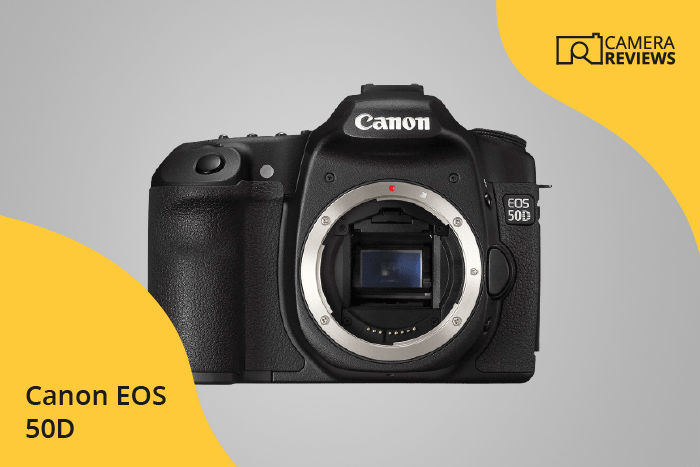Canon EOS 50D Specs and Scores

The Canon EOS 50D, a DSLR camera, receives a score of 48 out of 100. Announced on August 26, 2008, and released the same year, this camera was initially priced at $1,300. Measuring 146 x 108 x 74mm and weighing 822g (1.81lbs), the 50D’s specifications are now considered outdated in today’s market.
Despite its age, the EOS 50D remains a solid choice for enthusiasts seeking a reliable and well-built camera. However, newer models with advanced features and improved performance are more suitable for today’s photography standards.
Canon EOS 50D Overview and Optics
The Canon EOS 50D receives a score of 47/100 for optics. This camera features a 15.1-megapixel CMOS sensor, which is lower in comparison to current market offerings. Its shooting speed of 6.3 frames per second is decent, but not outstanding when compared to newer models. The camera operates with a Digic 4 processor and has a DXOMARK sensor score of 63.
Equipped with an APS-C sensor size, the EOS 50D is compatible with Canon EF-S lenses. However, it does not have built-in image stabilization, which could result in shaky images without proper technique or equipment. The camera has an aspect ratio of 3:2, which is standard for most DSLRs.
Considering these specifications, the Canon EOS 50D’s optics do not stand out in today’s competitive market. While it may have been a solid choice when released, advancements in technology have led to more powerful options for photographers.
Canon EOS 50D Video Performance
The Canon EOS 50D, despite its impressive specifications and optics, lacks video functionality. This camera only captures still images and does not record videos.
Canon EOS 50D Features and Benefits
The Canon EOS 50D receives a feature score of 54 out of 100. This score reflects several specifications that, while not on the cutting edge of today’s market, still have value for some photographers. The camera has a 3-inch screen with a resolution of 920,000 dots. However, it lacks a touchscreen, flip screen, GPS, WIFI, and Bluetooth capabilities.
In comparison to modern cameras, the EOS 50D falls short in terms of connectivity and user experience. The absence of a touchscreen and flip screen limits flexibility, while the lack of GPS, WIFI, and Bluetooth hinders seamless integration with other devices and location-based services. Despite these drawbacks, the 50D may still appeal to photographers who prefer a more traditional shooting experience and prioritize other aspects of camera performance.
Canon EOS 50D Storage and Battery
The Canon EOS 50D receives a storage and battery score of 35/100. With a single memory card slot, this camera accepts Compact Flash (Type I or II) and UDMA cards. The battery life is 800 shots, utilizing a BP-511A battery type. Unfortunately, USB charging is not available for this model.
In today’s market, the 50D’s storage and battery capabilities fall short compared to competitors. A single memory card slot is less convenient, and the lack of USB charging limits flexibility in power options. While the battery life is adequate, improvements in technology have led to longer-lasting batteries in more recent camera models.
Despite these shortcomings, the Canon EOS 50D remains a solid option for certain users. However, those seeking more advanced storage and battery features may want to consider other options within the market.
Canon EOS 50D Alternatives
Do you want to know how the Canon EOS 50D compares to its competitors? Have a look at the most popular comparisons for this camera below:
- Canon EOS 50D vs Nikon Coolpix P1000
- Canon EOS 40D vs EOS 50D
- Canon EOS 50D vs Fujifilm X-T30
- Canon EOS 50D vs Nikon D80
- Canon EOS 50D vs EOS 60D
- Canon EOS 50D vs Sony a7 III
Canon EOS 50D FAQ
Does the Canon EOS 50D Have Built-in Image Stabilization?
The Canon EOS 50D does not have built-in image stabilization. However, you can use lenses with image stabilization to achieve steadier shots.
Does the Canon EOS 50D Support 4K Video Recording?
The Canon EOS 50D does not support video recording, including 4K video. It is primarily designed for photography purposes.
What Size Sensor Does The Canon EOS 50D Have?
The Canon EOS 50D features an APS-C sized sensor, which is a popular sensor size for many DSLR cameras, providing good image quality and performance.
Does the Canon EOS 50D Have a Dual Memory Card Slot?
No, the Canon EOS 50D has only a single memory card slot, which supports CompactFlash cards.
Does the Canon EOS 50D Have a Touch Screen?
The Canon EOS 50D does not have a touch screen. It features a 3-inch LCD screen for image review and menu navigation.
Does the Canon EOS 50D Have Wi-Fi and Bluetooth?
The Canon EOS 50D does not have built-in Wi-Fi or Bluetooth connectivity. You will need to use alternative methods for transferring images.
Does the Canon EOS 50D Have GPS?
The Canon EOS 50D does not have built-in GPS functionality. You can use external GPS devices to geotag your images if needed.
Is the Canon EOS 50D Weather Sealed?
Yes, the Canon EOS 50D is weather-sealed, providing protection against dust and moisture, allowing you to shoot in various conditions.
Does the Canon EOS 50D Have a Built-in Flash?
Yes, the Canon EOS 50D has a built-in flash, providing additional lighting in low light situations or for creative purposes.

